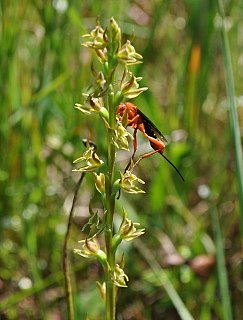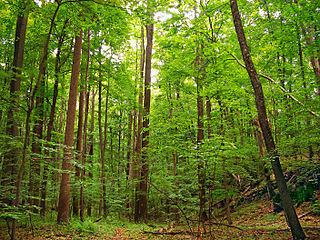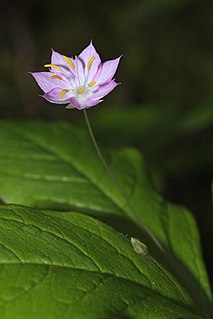
Prasophyllum petilum, commonly known as the Tarengo leek orchid, is a species of orchid endemic to eastern Australia. It has a single tubular, green leaf and up to eighteen pinkish mauve to greenish flowers, well-spaced along a slender flowering stem. It is a small orchid, difficult to locate, generally growing in taller grasses.

Prasophyllum sphacelatum, commonly known as the subalpine leek orchid, is a species of orchid endemic to south-eastern Australia. It has a single tubular, dull green leaf and up to eighteen scented, green to brownish flowers with a green to pinkish labellum. It grows in subalpine areas of New South Wales, Victoria and Tasmania.

Prasophyllum canaliculatum, commonly known as the channelled leek orchid or summer leek orchid, is a species of orchid endemic to a small area of southern New South Wales. It has a single tubular, bright green leaf and up to twenty five scented, greenish-red or brownish flowers on a flowering stem. It grows in woodland at altitudes around 1,000 m (3,000 ft) where only about two hundred plants survive.

Prasophyllum caudiculum, commonly known as the Guyra leek orchid, is a species of orchid endemic to a small area of northern New South Wales. It has a single tubular, bright green leaf and up to thirty five greenish to reddish-brown flowers crowded along an erect flowering stem. It grows in grassy places near Guyra.

Prasophyllum dossenum is a species of orchid endemic to a small area of northern New South Wales. It has a single tubular, dark green leaf and up to thirty scented pinkish-white and greenish-brown flowers crowded along an erect flowering stem. It is a rare orchid which grows in grassy places on the Northern Tablelands of New South Wales.
Prasophyllum erythrocommum, commonly known as the tan leek orchid, is a species of orchid endemic to Victoria. It has a single tubular green leaf and up to thirty small, greenish-brown to dark brown flowers. It is a very rare orchid, only known from a single small area north of Melbourne.
Prasophyllum fosteri, commonly known as the Shelford leek orchid, is a species of orchid endemic to a small region of Victoria. It has a single tubular green leaf and up to twenty five green to reddish-brown flowers. It is a very rare orchid, only known from a single population on a roadside.
Prasophyllum hygrophilum, commonly known as the swamp leek orchid, is a species of orchid endemic to Victoria. It has a single tubular green leaf and up to thirty greenish brown, pink or mauve flowers. It is a rare orchid only known from two populations and is classified as "endangered" in Victoria.
Prasophyllum incompositum is a species of orchid endemic to Queensland. It has a single tubular, dark green leaf and up to thirty scented, greenish-brown and white flowers. It has only been recorded from the Carnarvon National Park.
Prasophyllum incurvum is a species of orchid endemic to Tasmania. It has a single tubular, bright green leaf and up to forty brownish-green, white and purplish flowers. It is similar to P. alpestre but has larger flowers and petals which curve forwards.

Prasophyllum maccannii, commonly known as the inland leek orchid, is a species of orchid endemic to Victoria. It has a single tubular green leaf and up to forty green, greenish-pink or brownish flowers. It is found in the central-west of the state, growing in open forest.
Prasophyllum niphopedium, commonly known as the marsh leek orchid, is a species of orchid endemic to a small area in Victoria. It has a single tubular leaf and up to twenty greenish flowers with reddish markings. It is only known from five population on grassy alpine plains with the total number of individual plants less than five hundred.
Prasophyllum stellatum, commonly known as the Ben Lomond leek orchid, is a species of orchid endemic to Tasmania. It has a single tubular, dark green leaf and up to twenty greenish-brown to brownish flowers with a white labellum. It is only known from two disjunct populations, at Ben Lomond and near Deloraine.
Prasophyllum suaveolens, commonly known as the fragrant leek orchid, is a species of orchid species endemic to inland Victoria. It has a single bright green, tube-shaped leaf with a reddish base and up to twenty five green to yellowish-green flowers with red markings. The flowers are the smallest of any leek orchid found in Victoria.

Prasophyllum viretrum is a species of orchid endemic to Victoria. It has a single tubular, dark green leaf and up to thirty five scented, greenish-brown to brownish flowers and is only known from a few small populations in south-western Victoria.
Prasophyllum collinum is a species of orchid endemic to South Australia. It has a single tubular leaf and up to thirty lemon-scented, greenish brown and white flowers. It is only known from the Eyre Peninsula where it grows in sparse woodland.

Prasophyllum basalticum is a species of orchid endemic to New South Wales. It has a single tubular, dark green leaf and up to fifteen scented, greenish-brown to brownish-red flowers with a white and green labellum. It grows in grassy woodland on the Northern Tablelands.
Prasophyllum brevisepalum is a species of orchid endemic to New South Wales. It has a single tubular, shiny dark green leaf and up to thirty five scented, yellowish to brownish green and white flowers. It is only known from a single population growing in woodland near Inverell.
Prasophyllum graniticola is a species of orchid endemic to New South Wales. It has a single tubular, shiny dark green leaf and up to twenty five scented, greenish to brownish and white flowers. It is only known from two populations on the Northern Tablelands.
Prasophyllum pilligaense is a species of orchid endemic to New South Wales. It has a single tubular, shiny dark green leaf and up to thirty scented greenish brown to brownish and white flowers. It is only known from a few populations in the Coonabarabran district.















